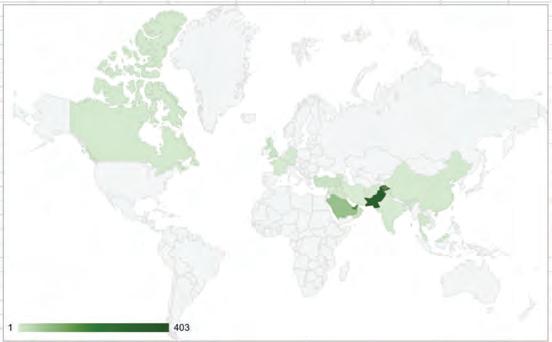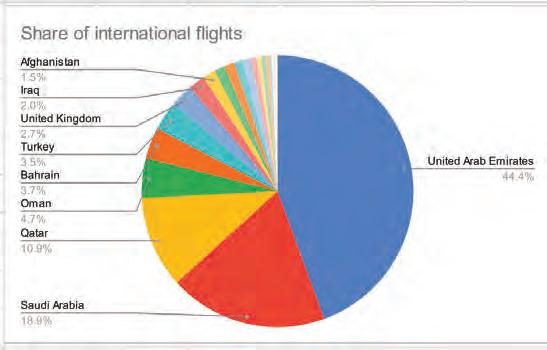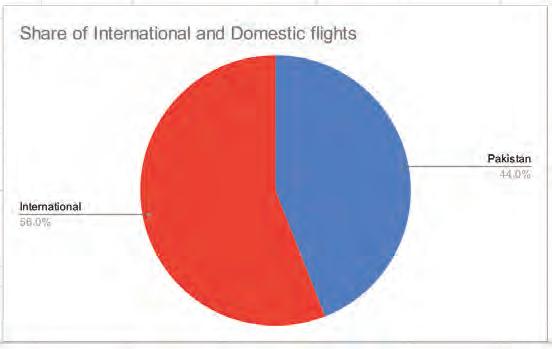
7 minute read
Pakistan is pretty connected for air travel
The country has more direct and indirect international flight connections than you might think.
By Ariba Shahid and Taimoor Hassan
Advertisement
You’re sick of your job, you’re tired of Karachi’s traffic, and you just want to get as far away as possible. Where do you go? Well the farthest place you could get to from Karachi is Pias in Peru. All it would take is a three-hour Qatar Airways flight to Doha, followed by a layover before a flight to Madrid, where you would have another layover. Another three hour flight later you would find yourself in Peru, except you’d be in Lima. To get to Pias, you would then board a domestic flight and finally make it as far away from Karachi as you possibly could. Easy-peasy, right? Not quite - but definitely possible. And that is sort of the point. Even though it was a hectic process (it would take you around 35 hours) Pakistan has better air-connectivity than one might think. The country is ranked 45th on the Air Connectivity Index of the International Air Transport Association (IATA) out of 219 total rankings, and has climbed up from 52nd spot in 2009. Compared to countries with similar or greater GDPs, Pakistan ranks better than Bangladesh, Iran and Sri Lanka for air connectivity.
Why does this index matter? Because global air travel is paramount to unlock a country’s economic potential by increasing foreign investment and flow of human capital, and, of course, tourism. No airport in Pakistan is considered a “connectivity hub.” However, because of a large expat population and a business class with deep ties to the Middle East, Pakistan’s access to the rest of the world is doing pretty well. Profit looks at how well connected Pakistan is, and why it matters.
What does air connectivity count for?
Much like Olympic medals, human rights violations, and war crimes, the world leaders in global air traffic are the United States of America and China, maintaining the first and second spots as most connected for at least the past decade. Japan comes in third after them. A country that is well connected to various destinations has better odds at fostering exchange of goods and services, investment and ideas, labor force, job creation, and of course tourists. In addition, more airport connectivity means more labor and earning opportunities associated with the sector. For Pakistan, increased connectivity also improves travel experience by reducing air travel time which also makes it a better tourist destination.
Airport connectivity is defined as the sum of direct and indirect connectivity of an airport. It is a scale to see the level of how well an airport is connected to the rest of the world in the form of direct flights to and from destinations, or indirect connections through other airports.
In contrast, hub connectivity facilitates a large number of connecting flights. The footfall at the airports of a country largely include passengers transiting, in addition to travelers to that destination.
While the US and China have consistently been the leaders, over time the Middle East has also emerged as a connectivity hub. No airport in Pakistan is actively considered a connectivity hub but because of a large influx of flights between Pakistan and the Middle East, connectivity has increased.

Pakistan’s air connectivity
Pakistan is home to around 151 airfields. There are major international airports in Pakistan now which include airports ar Karachi, Islamabad, and Lahore. Meanwhile cities like Peshawar, Multan, Sialkot, Faisalabad, Quetta, Rahim Yar Khan, Gwadar, Skardu, also serve as international airports. Civil airports in the country are operated by the Pakistan Civil Aviation Authority (CAA) with the exception of Sialkot International Airport, the country’s first privately owned and operated airport. An analysis of the flight data provided by the CAA over 28 January 2022 – 30 January 2022 shows that around 56% of all flights at the Karachi, Lahore, and Islamabad airports are international flights, whereas 44% are local. As per flightconnections.com, you can fly to 41 cities from Pakistan. This includes all major international airports - Islamabad, Karachi, Lahore, Peshawar, Sialkot, Multan, Faisalabad, and Quetta. Most of these cities are based in the Middle East. To put this in numbers, let’s look at the number of flights to and from the three biggest airports in the country - Karachi, Lahore, and Islamabad. A random sample of three days is taken from 29 January - 31 January, 2022. There were 97 flights to and from Dubai, 48 for Jeddah, 44 for Doha, and 40 for Sharjah. Cumulatively, this means 44.4% of all international flights flew to and from the United Arab Emirates, 18,9% between Saudi Arabia and Pakistan, 10.9% Qatar, 4.7% Oman, and 3,7% Bahrain. This shows how important the middle east is for the Pakistani aviation sector and airports. While the middle east is more accessible, Pakistani airlines no longer fly directly to multiple destinations in North America. PIA had direct flights to cities in the United States including New York. After over 50 years of service, PIA stopped flying to New York in October 2017. This is a result of TSA regulation preventing nonstop flights from Pakistan and the US. This leaves Toronto as PIA’s only destination in North America. This is also the longest direct flight one can get to and from Pakistan. As per flyconnections.com, the options in Europe are also limited with the United Kingdom, France, and Istanbul (the only city in the world that is made up of two continents). However, Profit’s analysis of CAA flight schedule shows that there are flights to and from Georgia and Germany too. It is possible that these are not frequent flights. While there is no surprise that there are no direct flights to far off destinations like Australia, Scandinavia, or South America, it is interesting to note that Central Asian Republics like Tajikistan,




How well connected is Pakistan for air travel?
If there is one industry that has drastically changed over the years, it’s the aviation industry. It’s one of the most sensitive industries out there considering the impact of terrorists attacks, rising fuel costs, global recessions, and ofcourse pandemics. These factors impact international connectivity for a country’s aviation industry. The keenness of an international passenger to transit through an airport in Pakistan is probably on the lower side of the spectrum considering the terrorism the country has battled over the years and the perception set out about safety concerns. In a previous story by Profit, we talked about how Pakistan’s airport connectivity is better than you think. An argument used was the fact that regular flights to London existed from Karachi, Lahore, Islamabad and Sialkot airport. Moreover, you could catch direct nonstop flights from Sialkot to cities like Milan and Barcelona every week. That has reduced significantly ever since PIA was banned from flying to Europe.Back in 2018, the top 5 international tourist arrivals by country of residence were the United Kingdom, United States, India, Canada, and People’s Republic of China. The top five busiest direct flight arrivals were United Arab Emirates, Saudi Arabia, Qatar, Oman, and Bahrain. The topfive busiest air cargo routes were the United Arab Emirates, Qatar, Saudi Arabia, Turkey, and Thailand. As per the IATA, The Middle East was the largest market for passenger flows to Pakistan, followed by AsiaPacific and Europe. 6.1 million passengers arrived in Pakistan from the Middle East (51.5 per cent of total), 4.1 million passengers arrived from AsiaPacific (34.6 per cent of the total) and 1.2 million passengers arrived from Europe (9.8 percent). Despite all this, like we said earlier, airport connectivity is not just the number of cities you can take a direct flight to and from, it also includes the total number of indirect flights you can take. The very fact that there are frequent flights to Dubai, Abu Dhabi, and Doha from Pakistan show just how connected the country really is. It is entirely possible that you can fly to nearly any corner of the world by transiting through these three airports. The very fact that there are a frequent number of flights on a daily basis makes Pakistan better connected than you’d expect. n










